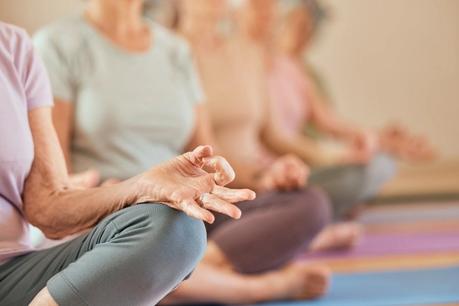From a recent study published in Nutrients researchers examined the combined effects of yoga and the Mediterranean diet (MD) on various health outcomes in community-dwelling older adults.
Their findings indicate that this twelve-week intervention significantly improved participants' nutritional status, balance, gait, flexibility and muscle strength.

Background
Spain has seen a significant increase in its elderly population, currently around 20%, which is expected to reach 29% by 2060. Aging brings physiological changes that affect nutrient absorption, appetite and the risk of malnutrition, in addition to an increase in body fat and a decrease in muscle mass.
Older adults also experience decreased physical functionality, including flexibility, balance, and muscle strength, due to decreased physical activity and age-related changes in connective tissue and proprioception. These changes increase the risk of falls, injuries and reduced quality of life.
To counteract these effects, strategies such as diet and exercise are essential. The MD, which emphasizes plant-based foods, moderate fish, poultry, dairy and limited red meat, provides essential nutrients to support overall health.
Exercise, especially mind-body therapies such as yoga, offers significant benefits. Yoga improves nutrient absorption and improves digestion, flexibility, range of motion and muscle strength, contributing to better overall health and functional independence in older adults.
About the study
This study aimed to evaluate the combined impact of MD and yoga on the nutritional and functional health of older adults.
Researchers used a randomized controlled trial to examine the effects of a twelve-week yoga and MD intervention on the flexibility, balance, grip strength, and lower body strength of non-institutionalized older adults.
A sample of 118 participants aged 65 years or older were recruited via phone calls and emails, meeting criteria including no recent participation in yoga and the ability to understand program instructions.
Participants were randomly assigned to an experimental or a control group, each with 59 participants, using a computer-generated system, with participants and researchers blinded to group assignment.
The experimental group participated in bi-weekly yoga sessions and followed an MD diet, while the control group continued their usual activities and diet.
Data collected included demographic information, MD compliance, nutritional status, flexibility, balance and muscle strength, which were assessed before and after the intervention.
The data analysis included several statistical tests, including univariate and ANOVA, to compare pre- and post-intervention results, with significance set at p < 0.05 and effect sizes calculated using Cohen's.
Findings
The study included 36.96% male and 63.04% female participants, with a high adherence rate to intervention sessions (91.6%). No injuries or adverse reactions were reported.
Significant improvements were observed in several health metrics after the combined yoga and MD intervention.
Adherence to the MD showed significant group differences (and improvements over time, with a notable effect size (Cohen's d = 2.18). Nutritional status also improved significantly, although group differences were less pronounced (Cohen's d = 0. 05).
Balance and gait showed moderate improvements, with balance and gait showing significant differences after the intervention (Cohen's d = 0.40 for balance, 0.42 for gait).
Improvements in flexibility were significant across multiple body parts, with the right arm and left leg showing notable effect sizes (Cohen's d = 0.43 and 0.37, respectively).
Another finding was that the group that received the MD intervention in combination with yoga training showed greater differences between pre-intervention and post-intervention measures of muscle strength.
In particular, lower body strength and grip strength showed significant differences (Cohen's d = 0.39 for grip strength, 0.81 for lower body strength).
Conclusions
The study concluded that a 12-week intervention combining an MD intervention with yoga significantly improved nutritional status, balance, gait, fall risk, flexibility, and muscle strength in non-institutionalized older adults.
These findings are consistent with previous research suggesting the benefits of exercise and MD for older adults.
The strengths of the study include its randomized, controlled and blinded design, high participant compliance and large sample size, which increase the validity of the results.
However, the study has limitations, such as the inability to blind participants, the short-term nature of the effects evaluated, and the integrated nature of the intervention, making it difficult to isolate the specific contributions of yoga or diet alone.
Future research should consider separate group designs for each intervention to better understand its individual effects.
Despite these limitations, the study underlines the importance of exercise and dietary interventions for improving the health and well-being of older adults, potentially informing public health policies aimed at promoting healthy aging and reducing the burden of chronic diseases.
Magazine reference:


